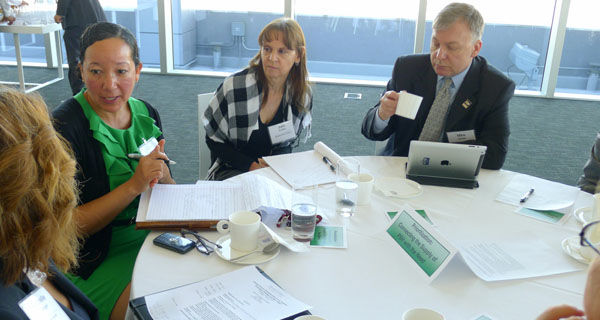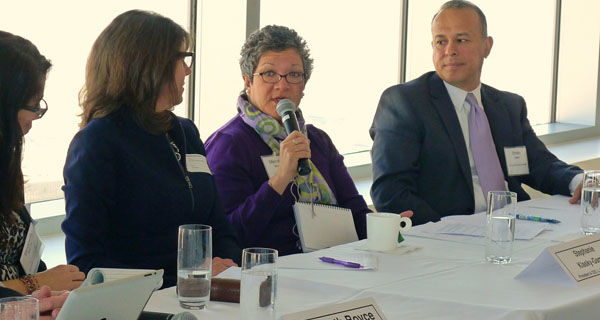On February 13, Chairman, President & CEO, Steven N. Hilton welcomed nearly 70 guests to the Conrad N. Hilton Foundation’s convening on Ending Chronic Homelessness in Los Angeles: Evaluation Findings and Next Steps.
On February 13, Chairman, President & CEO, Steven N. Hilton welcomed nearly 70 guests to the Conrad N. Hilton Foundation’s convening on Ending Chronic Homelessness in Los Angeles: Evaluation Findings and Next Steps. On the 30th floor of the AT&T building, grantees, philanthropic, and public sector partners enjoyed a dramatic backdrop view of Downtown Los Angeles and heard findings and recommendations from the year-one evaluation report for our Initiative to End Chronic Homelessness in Los Angeles, as presented by third party evaluators, Abt Associates, Inc.
As part of the Foundation’s effort to understand how to most effectively reduce and eliminate chronic homelessness in Los Angeles, we hired Abt Associates in September 2011 to evaluate the Foundation’s Chronic Homelessness initiative. The goal of the evaluation is to answer this overarching question about our grantmaking: is our Chronic Homelessness initiative an effective way to end and prevent chronic homelessness in Los Angeles County?
Brooke Spellman of Abt Associates presented preliminary results from the evaluation. The goals for $90 million in public and private sector funds, along with 4,000 new permanent supportive housing units being made available, are on track. Other objectives, on the other hand, are moving slower than anticipated: increasing political will, systemizing and coordinating housing prioritization for the most vulnerable homeless people, and helping service providers and developers provide more permanent supportive housing. The evaluation also revealed that, in measuring and reaching some goals, there were challenges with the availability of data. Better data collection in the future will improve tracking and help inform planning, decision-making, and accountability.
After the main presentation, attendees engaged in table discussions addressing three main topics highlighted in the year-one evaluation and developed recommendations for next steps. One question asked for recommendations on how progress can be made toward a shared data inventory of permanent supportive housing that is accurate, useful, and accessible. Other tables were asked to identify the biggest gaps in the supply of permanent supportive housing and how to address the problem. Remaining participants made recommendations to create a coordinated entry system—both at the community and regional levels—to prioritize and match persons who are homeless with the appropriate housing resources.

There was a vibrant cross-sector discussion on a range of challenges and promising developments on each of these topics. Recommendations were presented to a panel of public, non-profit, and private stakeholders to share further insights. Panelists included Elizabeth Boyce, Homeless Coordinator for Los Angeles County; Emilio Salas, Deputy Executive Director of the Housing Authority of the County of Los Angeles; Fred J. Ali, President & CEO of the Weingart Foundation; Mercedes Marquez, Deputy Mayor for Housing & General Manager at the Los Angeles Housing Department; Michael Arnold, Executive Director of the Los Angeles Homeless Services Authority; and, Stephanie Klasky-Gamer, President & CEO of L.A. Family Housing.

After the meeting was adjourned by Bill Pitkin, Director of Domestic Programs at the Hilton Foundation, conversations continued around the room, as attendees discussed possible next steps and partnerships. The Foundation will continue to hold these kinds of meetings to engage partners in sharing lessons learned and recommendations for the future.
For details on the evaluation, read the year-one evaluation report released in October 2012 or view the powerpoint presentation shared at the recent convening. To see more photos of the event, please visit our Flickr account.